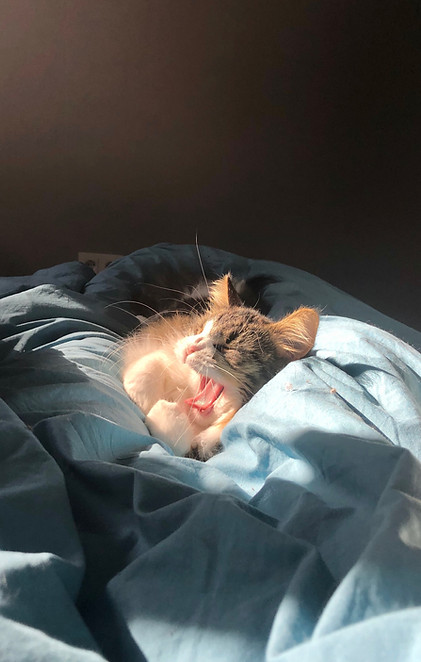
SERVICES
RESOURCES
LIGHT OF LIFE
VETERINARY CLINIC
ANAESTHESIA

"Anesthesia" derived from the ancient Greek word "anaisthaesia", meaning "insensibility," and is used to describe the loss of sensation to the whole or any part of the body [2,11].
Anaesthesia involves medication that creates a level of unconsciousness and at the same time creates a good level of analgesia to reduce any pain the pets may be having [1, 2, 5, 6,10,11]. However, the requirements and peculiarity of different species, age groups, and disease states necessitate the mastering of the use of a variety of drugs, drug combinations and administration methods [2,3,4,8,11].
Knowledge and advances in this field of anaesthesia over the years have been significant. We have better techniques to block sensation locally or over a region of the body without
causing a total loss of consciousness [1,2,5,12], an array of drugs and methods of drug administration available for us to manage pain [1,6,7,11,12], and an increasing availability of monitoring equipment to help us keep track of the physiological function of the patient's body during full anaesthesia with the aim of reducing morbidity and mortality [3,4,6,11,12].
Certain types of anaesthesia may be recommended for some non-surgical procedure in order to reduce stress and anxiety in the pet which can result in other adverse condition, for example, implanting a microchip into a nervous dog [10,11,12].
TYPES OF MODERN
ANAESTHESIA [11]
INHALATION
Anesthetic gases or vapors are inhaled in combination with oxygen.
INJECTABLE
Anesthetic solutions are injected intravenously, intramuscularly, and subcutaneously.
COMMONLY USED TERMS [1,11,12]
LOCAL ANAESTHETIC (LA)
Your pet will be kept awake and may be mobile; only certain affected areas are made to lose sensation.
This is usually for compliant pets, superficial procedures or as postoperative pain management.
GENERAL ANAESTHETIC (GA)
Your pet is given medication to induce complete loss of consciousness.
This permit the performance of surgeries or other potentially painful procedures.
GAS INDUCTION
Your pet will be induced into a loss of consciousness by gaseous anaesthetic medication instead of injected medication.
This approach is recommended for older or high risk patients.
SEDATION
Temporary creating a state of calmness or more tranquil consciousness. The adverse effects that may be associated with general anesthesia are avoided with sedation.
Pets are able to maintain most of their natural physiological reflexes and are capable of breathing on their own in most cases.
WHY PROPER KNOWLEDGE AND ANAESTHETIC PROTOCOLS FOR DIFFERENT SPECIES ARE IMPORTANT
Data collected from a UK study.
Mortality risks in smaller animal species were generally appears higher than dogs, cats or rabbits, although there was no data on the overall health condition of the individual anaesthetised patients to allow proper estimation of ASA stratum-specific risks in this study [4].
Birds and small mammals (such as hamsters, chinchillas and mice) appeared to be at a higher risk due to their small body size and high surface area to volume ratios predispose them to hypothermia while their high metabolic rates predispose them to hypoglycaemia during anaesthesia.
Most are also too small in size for the placement of intratracheal tubes, thus not allowing a patent airway to be maintained or achieve adequate ventilation during anaesthetic.
These are the existing challenges contributing to the high perioperative mortality rate of smaller sized animals [4].
AVERAGE ANAESTHETIC FATALITY DATA COLLECTED FROM 117 IN VET CENTRES FOR DIFFERENT COMMON PET SPECIES IN UK [4]

Therefore, before any anaesthesia or sedation can be carried out, the patient needs to be assessed carefully using the American Society of Anesthesiologists (ASA) risk classification method [2,5] to determine the appropriate and safer anesthetic method(s).
Anesthetic issues and concerns can be common, but mortality from them should be rare when appropriate modern, anaesthetic methods and monitoring are implemented. These can help and lead to the early recognition and correction of the impending problems [2,11].
- 01
- 02
- 03
- 04
- 05
- 06
OUR CLINIC PROTOCOL FOR
DOGS AND CATS TO REDUCE RISKS
-
A 7-Point Pre-GA Physical Examination
-
A Pre-GA Quantitative Analysis -
-
Blood Tests and Urinalysis
-
-
Intravenous Fluid Therapy (below), Catheterisation in Blood Vessel
-
Fluid and electrolyte balance of an animal is an important factor to achieve uncomplicated recovery after operation [2,5,6,9].
-

Above: The minimum parameters that should be monitored at 3 minutes interval according to American College of Veterinary Anesthesiologists. Table adapted from A Color Handbook, Small Animal Anesthesia and Pain Management, 2nd Ed.
-
Anaesthetic Gas Induction [3] for Older Pets
-
Preoperative monitoring
-
To determine the existence and magnitude of physical or ASA condition that can compromise a patient's response to anesthesia and the planned procedure(s), and to guide the development of the customized anesthetic plan [2,3,5,10,11].
-
-
Intraoperative monitoring (through out the planned procedure(s)
-
To ensure stable and optimum anesthetic depth with minimal physiological impairment during general anaesthetic [2,3,5,6,7,10,11].
-

Above: Fluid pump ensures a consistent fluid flow into the patient directly through their blood vessels for maintaining hydration, oxygen circulation and blood pressure [2,5,6].
Pic by LOLVet

Above: Intravenous access to the pets with appropriate sized catheter is vital for all general anaesthetic and surgical procedures as it allows proper control and quick access to resolve and correct any perceived physiological issues [5].
Pic by LOLVet
-
Postoperative monitoring
-
To ensure a full and complete recovery from the anesthetic state and to provide adequate analgesia by administering appropriate type and quantity of pain modulating medication [2,3,7,10,11].
-
-
Post surgical updates and reviews with owners.
OWNER'S GUIDELINE FOR
PRE-ANAESTHETIC PREPARATION[2]
Your pet will be given intravenous fluid therapy to maintain hydration and blood pressure [6] and given food once they have fully recovered from anaesthetic .
We use medical grade oxygen to ventilate and anaesthetic agents to maintain all their anaesthesia.
We aim to keep all procedures within 45 minutes to reduce anaesthetic/surgical-associated complications. However, there are some surgical procedures that require more time.
We will need 3-4 hours to monitor your pets to ensure that they are completely awake and fully recovered from the anaesthetic. This may be longer if your pet is older/ ill. In this case, hospitalisation may be recommended.
You should offer a small amount of food and water 1/2 hour after reaching home.
Your pet may still be sleepy and may fall asleep at home before eating or drinking again.
Allow your pet to sleep for a few hours, then offer a small amount of food and water again.
Instruction for after-care will be given to you (the owner) to further guide you through the recovery period.
You will have to arrange for a review assessment of the surgical area as stipulated by our veterinarian.
-
To withhold food from your pet
for 12 hours before anaesthesia.
-
To withhold water from your pet
for 4 hours before anaesthesia.
A full stomach increases the risk of choking during anaesthesia for dogs and cats.
Fasting guidelines are different for the other species, please contact our clinic to clarify.

Attribution:
1. Campoy, L., Read, M.R. (2013). Small Animal Regional Anesthesia and Analgesia. UK: Wiley-Blackwell
2. Clarke, K. W., Trim, C. M., Hall, L. W. (2014). Veterinary Anaesthesia, 11th Ed. UK: Saunders.
3. Cooley, K.G., Johnson, R.A. (2018). Veterinary Anesthetic and Monitoring Equipment. UK: Wiley-Blackwell
4. Brodbelt, D.C. (2006). The Confidential Enquiry into Perioperative Small Animal Fatalities. Acc 11 May 2019, https://www.rvc.ac.uk/Media/Default/staff/files/dbrodbelt-thesis.pdf
5. Dugdale, A. (2010). Veterinary Anaesthesia Principles to Practice. UK: Wiley-Blackwell.
6. Ko, J.C. (2019). A Color Handbook, Small Animal Anesthesia and Pain Management, 2nd Ed. US: CRC.
7. Ludders, J.W., McMillan, M. (2017). Errors in Veterinary Anesthetic. UK:Wiley-Blackwell
8. Petritz, O.A. No Pain, No Gain: Updates on Analgesia in Birds and Small Mammals. Acc 8 May 2019, https://studyres.com/doc/13463884/no-pain--no-gain---colorado-veterinary-medical-association
9. Snyder, L.B.C., Johnson, R.A. (2015). Canine and Feline Anaesthesia and Co-Existing Disease. UK: Wiley-Blackwell.
10. Steagall, P., Robertson, S., Taylor, P. (2018). Feline Anesthesia and Pain Management. UK: Wiley-Blackwell
11. Tranquilli, W. J., Thurmon, J. C., Grimm, K. A. (2007). Lumb & Jones' Veterinary Anesthesia and Analgesia, 4th Ed. USA: Blackwell
12. Merckvetmanual
NEED MORE INFORMATION?
If you are interested to learn more about the anaesthesia procedure required for your pet, you can contact us at 6243 3282 to schedule an appointment.
LOCATION
Blk 703 Bedok Reservoir Road
#01-3508 Singapore 470703
CONTACT
Tel: 6243 3282
(By Appointment Only)
Email: AskLightofLifeVet@outlook.com
OPERATING HOURS
WED & SUN
5 pm to 10 pm
THURS TO SAT
2 pm to 4 pm, 5 pm to 10 pm
CLOSED MON, TUES
& ALL PUBLIC HOLIDAYS



